The first tanks of Sweden. Part I
Landsverk L-5
The first Swedish tank of its own production (but not development) was the Landsverk L-5 combat vehicle, also known as Stridsvagn L-5, GFK and M28. This tank was designed in Germany, and the Swedish company Landsverk was attracted to the project as a prototype construction company. In the mid-twenties, when the L-5 tank was created, the German authorities tried to hide all the projects of military equipment, because of which foreign organizations were involved in the creation of a promising light tank.
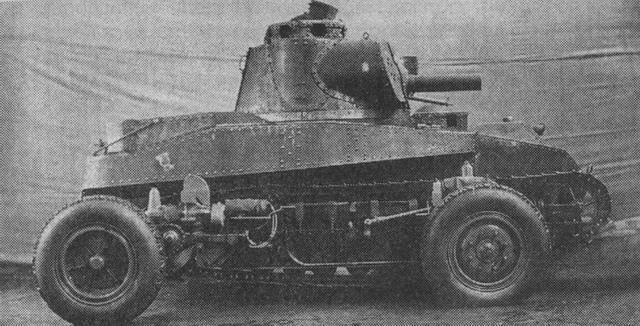
The GFK project (this was the name it used to carry in Germany) was believed to have emerged under the influence of the English ideas of the early twenties. Seeing the latest foreign technology, the German military and designers began to develop several projects of similar machines. It is worth noting that only one of them reached the stage of testing the prototype, which was created under the guidance of designer O. Merker. For obvious reasons, there were no major innovations in the GFK project, with the exception of a few original ideas. This light tank used a number of well-known and mastered by that time technical solutions, which could ensure the comparative simplicity of the production of equipment at enterprises of third countries that do not have their own tank design.
Perhaps the most interesting feature of the GFK / L-5 project was the original chassis. The caterpillars of that time had a small resource, which is why German engineers decided to equip a new combat vehicle with a combined wheeled and tracked undercarriage. A multi-tracked caterpillar propulsion unit with a front guide and rear drive wheel was attached directly to the sides of the tank. In addition, on the sides of the hull, next to the caterpillar, provided for the suspension of the wheels with their lifting system. The engine torque was transmitted to the wheels through separate transmission units. The gearbox and driving rear wheels were connected using a chain drive.
It was assumed that the new tank GFK will be able to move on the roads on wheels and before the battle on rough terrain to move to the tracks. Such an opportunity could provide a promising tank with high mobility in combat conditions and at the same time did not lead to increased consumption of an already small track resource.
It can be said that the combined propeller was the only truly original idea in the GFK / L-5 project. All other components and assemblies of the new tank were made in accordance with the usual technologies of the time. The body was proposed to be assembled with rivets from relatively thin sheets of bulletproof booking. The layout of the internal volumes was carried out according to the classical scheme: in the front of the building a control compartment was placed with the workplace of the driver. Behind it was placed the fighting compartment with a swivel tower, and the hull-like hull was allocated for the engine and transmission. For the convenience of the driver, his workplace provided a small cabin with inspection slits. Office of management was shifted to starboard. At the left there was a separate armored cabin with a MG 08 machine gun of 7,92 caliber mm.
The main armament of the GFK tank was located in the swing turret. It consisted of one 37 caliber mm gun and one MG 08 machine gun. Like some other tanks of the time, the new German car had no paired weapons. The cannon and turret machine gun were installed on separate supports and because of this they had different pointing angles. Thus, the instrument could be guided vertically in the range from -10 ° to + 30 ° from the horizontal. The corners of the vertical guidance of the machine gun were larger: from -5 ° to + 77 °. The turning mechanisms of the tower made it possible to attack targets in any direction. Inside the fighting compartment, we managed to place 200 shells for 37-mm cannons and 1000 cartridges for a turret machine gun. Another 1000 ammunition designed for course machine gun in front of the case.
Like some other light tanks of the twenties, the GFK received two sets of controls. One of them was located on the workplace of the driver, and the other - in the back of the crew compartment. It was assumed that the second driver will provide greater maneuverability, and if necessary, will be able to remove the damaged car from the battlefield. It was not possible to find out how justified such a decision was. The only confirmed consequence of the use of two driver's places was the tightness inside habitable volumes. The crew consisted of four people: two driver-mechanics, a commander and a machine gunner. It was assumed that the "free" driver could help other crew members in preparing the gun for firing.
Tank GFK turned out relatively small and light. With a length of about 5 meters, a width of about 2 m and a height of no more than 1,5 meter, the machine had a combat mass of about 7 tons.
By the time the design was completed, the German light tank received a new designation - the Räder-Raupen Kampfwagen M28. The Versailles Peace Treaty did not allow Germany to build, test and use tanks. Because of this, German tank builders had to turn to foreign organizations for help. It should be noted that the German military did not want to take risks and therefore long enough to pull with the decision. As a result, it was decided to build an experimental batch of six light armored vehicles.
The further implementation of the project M28 attracted the Swedish company Landsverk. She was handed the project documentation and commissioned to build prototypes of the new tank. Apparently, to preserve secrecy, Swedish industrialists renamed the M28 project as L-5. It was under this name that he later became widely known.
In 1929, Landsverk built the first of the most experienced armored vehicles. In 30, the assembly of the remaining five has ended. Six prototype tanks differed from each other in some design features. Thus, the first three tanks received a four-cylinder carburetor engine manufactured by Daimler-Benz with an 60 horsepower Xp. The remaining three cars were equipped with Bussing-NAG D7 petrol engines with 70 horsepower. During the tests it was supposed to compare the capabilities of the tank with different power plants. In addition, it was planned to compare the electric and hydraulic systems lifting the wheels. The first four prototypes received electric, the fifth and sixth - hydraulic.
Soon after the construction was completed, tests of six prototype tanks began. At this stage, the project again became the subject of international cooperation. The fact is that five L-5 tanks were tested in Sweden. The sixth, in turn, went to the Soviet Union, to the Kama tank school in Kazan, where German tank crews were trained at that time. Despite testing at different test sites, the responses of German test tankers were generally similar. With an acceptable firepower and a sufficient level of protection, the L-5 tank had ambiguous driving characteristics. The wheel lift system was too complex, and its placement outside the armored hull had a negative effect on survivability in combat conditions.
Since the GFK / M28 / L-5 tank did not have any advantages over other German-made armored vehicles, work on it was stopped. In 1933, an experienced tank, tested in Kazan, was sent back to Sweden. The fate of the six experimental machines is unknown. Most likely, they remained at the Landsverk plant, where they were later dismantled. Reliable data on this account is missing.
Landsverk L-30
Soon after receiving the design documentation for the M28 / L-5 tank, the Swedish designers from Landsverk decided to create their own project for a similar purpose combat vehicle. After discussing the prospects for such technology, it was decided to develop two tanks on the basis of L-5. One of them was supposed to be an improved version of the German project with a combined chassis, and the second was supposed to equip only tracked propulsion. These projects received the designations L-30 and L-10, respectively.
Work on the improvement of the German project did not take much time. The design of the wheeled / tracked tank L-30 lasted only a few months. For 1930, Landsverk employees managed to create a technical design, and then build the first and, as it turned out, the only copy of the new tank.
In its basic features, the L-30 light tank was similar to its predecessor, however, when creating the project, the Swedish engineers took into account the deficiencies identified by the latter. Therefore, the design of the machine has undergone significant changes. The layout of the hull remained the same: the control compartment in the front, the combat compartment in the middle and the engine-transmission compartment - in the aft one. The workplace of the driver on the L-30 tank, unlike the L-5, was placed at the left side. In addition, the crew was reduced to three people, because it was decided to abandon the second driver’s workplace, which did not give any particular advantages.
The armored hull of the light tank L-30 was supposed to be welded from rolled armor plates. The front hull sheet had a thickness of 14 mm, the rest - up to 6 mm. It should be noted that in the manufacture of the hull of a prototype tank, Swedish industrialists decided to save money and assembled it from ordinary steel. However, this did not prevent to conduct tests and draw the necessary conclusions.
At the rear of the hull, a Maybach DSO12 8-cylinder hp gasoline engine with a capacity of 150 hp was placed. Next to it was a transmission designed to transmit torque to both engines.
The undercarriage was the weakest point of the M28 / L-5 project. Despite all the advantages, the combination of tracked and wheeled propulsion was not reliable enough. The designers of Landsverk took into account the experience of German colleagues and created their own version of the combined chassis. First of all, they simplified the tracked undercarriage and thereby increased its reliability. On each side of the tank there are four track rollers left. They were interlocked by two and equipped with leaf springs. In addition, the track undercarriage included two supporting rollers, a front guide and a rear drive wheel.
The wheeled undercarriage of the L-30 tank as a whole was based on German developments, but there were several innovations in its design. Thus, the attachment points for the wheel propulsion were located on board the tank, above the support rollers and under the upper branch of the track. Four wheels with pneumatic tires equipped with a suspension with vertical springs. The mechanism for lowering and lifting wheels, according to some sources, was electrically driven. When driving on wheels was only the rear axle.
All the weapons of the tank L-30 was in the tower. The prototype received an 37-mm rifled Bofors cannon and an 7,92-mm machine gun paired with it. The design of the conical turret allowed later on to change the composition of the tank’s weapons, placing a suitable weapon or a machine gun of a different model on it. In addition, some sources mention the possibility of installing an additional machine gun in the front of the hull, next to the workplace of the driver. Inside the fighting compartment, we managed to place the 100 projectiles for the cannon and the 3000 cartridges for the machine gun.
The tank of its own Swedish development was significantly larger and heavier than the German prototype. Thus, the combat weight of the L-30 machine exceeded 11650 kg. Some interest are the dimensions of the new combat vehicle. The Swedish development tank was slightly longer than the German one (overall length 5180 mm) and much higher - its height on the roof of the tower reached 2200 mm. Due to the change in a large number of elements of the undercarriage, the L-30 tank turned out to be approximately 60 cm wider than the L-5.
The tests of an experienced Landsverk L-30 tank started at the very end of the 1930 of the year. The updated chassis clearly demonstrated its high performance. When using the tracks, the tank moved on the highway at speeds up to 35 km / h, and on wheels it accelerated to 77 km / h. Cruising range reached 200 kilometers. Similar characteristics of mobility were high enough for the very beginning of the thirties. Nevertheless, the commission of the military department of Sweden had claims to a new combat vehicle. The use of tracked and wheeled propulsion complicated the design, as well as adversely affected the simplicity and ease of operation.
The further fate of the L-30 project was determined by comparison with another tank based on the German L-5 - L-10. Wheel-tracked armored car surpassed it only in speed on the highway when driving on wheels. Comparison of other characteristics either did not show any advantages of the L-30 tank, or was not in its favor. As a result, the Landsverk L-10 tank, which received the new designation Strv m / 31, was adopted by the Swedish army.
***
The L-30 project turned out to be the last Swedish attempt to create a light tank, the chassis of which could combine all the best sides of the tracks and wheels. Tests of seven armored vehicles of two models showed not only the advantages of the applied technical solutions, but also their serious disadvantages. Some problems of the tank L-5 were corrected in the project L-30, however, this did not lead to the emergence of technology suitable for practical use. The overall architecture of the wheeled-tracked undercarriage was too complicated to manufacture and operate, and also did not give any tangible advantages over tracked or wheeled vehicles. Further development of the Swedish tank building followed the path of creating purely tracked vehicles, and the L-10 light tank, based on the L-5, to some extent became the basis for several of the following types of armored vehicles.
On the materials of the sites:
http://www2.landskrona.se/
http://aviarmor.net/
http://militaryfactory.com/
http://tanksinworldwar2.com/
http://protanki.com/
- Ryabov Kirill
- The first tanks of Sweden. Part I
The first tanks of Sweden. Part II
Armored cars of Sweden. Part I
Armored cars of Sweden. Part II
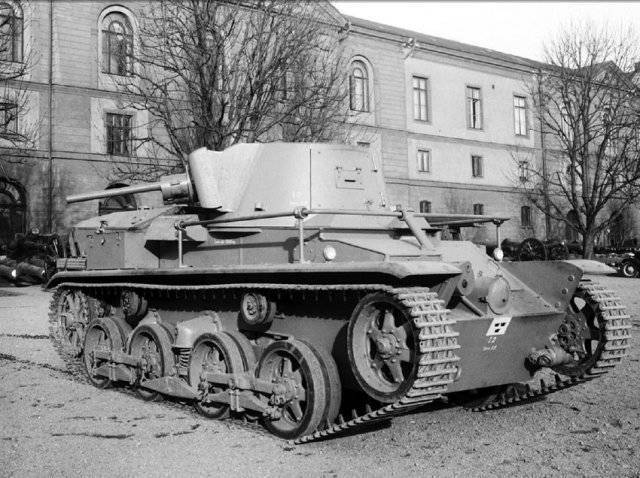
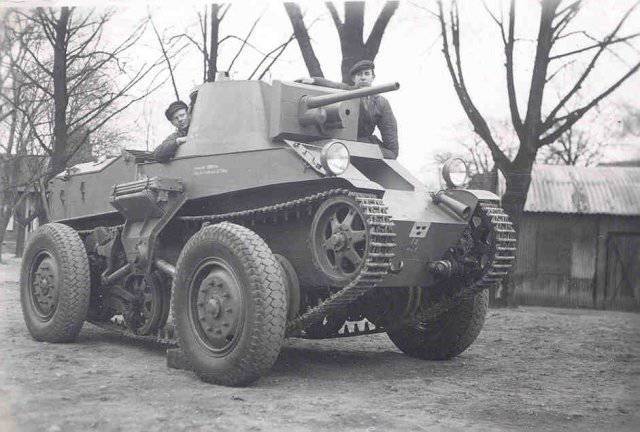
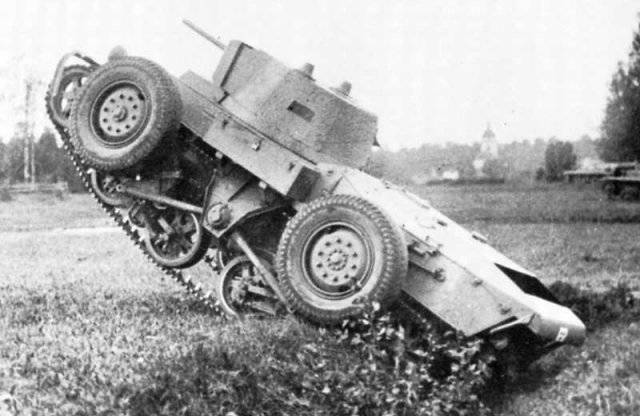
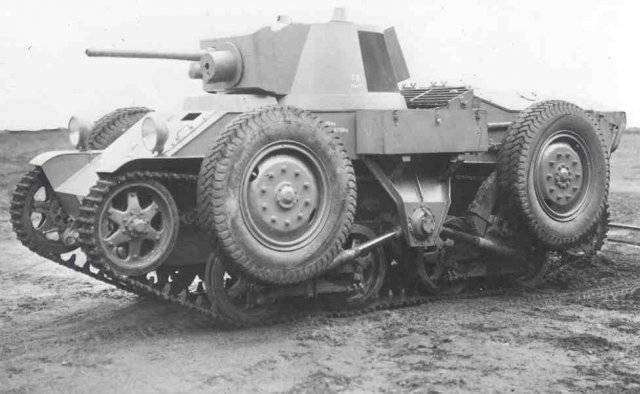
Information